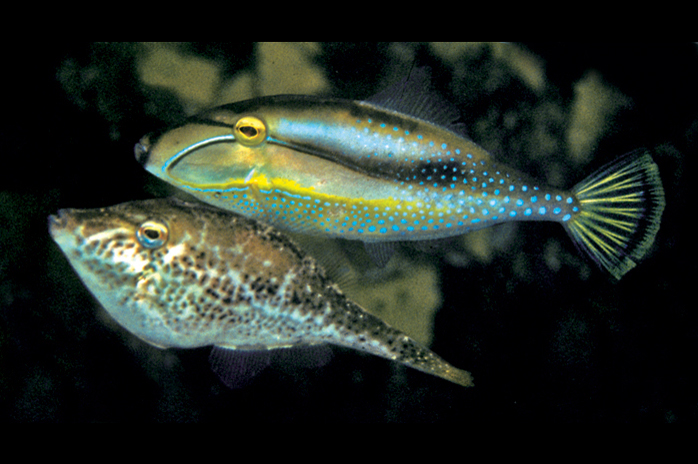- Classification
- ACTINOPTERYGII
- TETRAODONTIFORMES
- MONACANTHIDAE
- Acanthaluteres
- spilomelanurus
Bridled Leatherjacket, Acanthaluteres spilomelanurus (Quoy & Gaimard 1824)

A pair of Bridled Leatherjackets, Acanthaluteres spilomelanurus, in Port Phillip, Victoria. Source: Rudie H. Kuiter / Aquatic Photographics. License: All rights reserved
A small slender leatherjacket with a minute pelvic-fin rudiment, and a stout, serrated, four-edged dorsal-fin spine. Males are pale greenish, with bridle-like stripes on the head and mid-sides, and a distinctive black band near the edge of the tail. Females and juveniles are mottled brown often with black spots, sometimes with an indistinct bridled pattern before the eyes.
Bridled Leatherjacket, Acanthaluteres spilomelanurus (Quoy & Gaimard 1824)
More Info
|
Distribution |
Widespread in southern Australia, from Port Stephens, New South Wales, to north of Jurien Bay, Western Australia, and around Tasmania. Bridled leatherjackets often inhabit seagrass beds and macroalgae in shallow bays and estuaries, at depths of 1-15 m. |
|
Features |
Dorsal fin II (second spine minute) + 27-34; Anal fin 26-32; Caudal fin 12; Pectoral fin 10-11; Vertebrae 20. Body elongate, of moderate depth, very compressed, with a small to moderately sized ventral flap; caudal peduncle shallow. Head large, acutely pointed; eyes small; mouth very small; teeth large, all truncate, single row in each jaw; gill openings in form of small slit mostly above each pectoral fin base. Skin velvety to touch; caudal peduncle without spines or bristles; lateral line difficult to detect. Two dorsal fins, first dorsal above eyes, consisting of prominent four-edged spine with row of downward-directed barbs along each edge, spine wholly received into deep spinal groove when depressed, second dorsal widely separated from first, of moderate length, somewhat elevated anteriorly in males, outer margin slightly; anal fin similar to and opposing second dorsal; caudal fin rounded. Pectoral fins moderately small, rounded. Pelvic fins reduced to minute rudiment, difficult to detect without magnification. |
|
Size |
A small species reaching 14 cm, commonly to 8 cm. |
|
Colour |
Males with greyish brown body and green back; black-edged blue line extending from chin to each eye and along midside of body; second black line running from lower jaw to each eye, via dorsal surface of snout; irregular yellow stripe extending from throat along lower side of body; numerous blue spots on caudal peduncle and upper and lower surfaces of body; caudal fin yellow with black bar near rear border. Juveniles and females with pale green to pale brown head and body, usually with faint brownish stripe from mouth though each eye to caudal base; numerous brown spots generally present on head and body; caudal fin green to yellow, usually with two faint dusky cross bars. |
|
Species Citation |
Balistes spilomelanurus Quoy & Gaimard 1824, Voyage autour du Monde 1: 217. Type locality: Port Jackson. |
|
Author |
Bray, D.J. 2022 |
|
Resources |
Bridled Leatherjacket, Acanthaluteres spilomelanurus (Quoy & Gaimard 1824)
References
Castelnau, F.L. de 1872. Contribution to the ichthyology of Australia. 1. The Melbourne fish market. Proceedings of the Zoological and Acclimatisation Society of Victoria 1: 29-242 1 pl. (as Monacanthus forsteri) See ref. at BHL
Edgar, G.J. 2008. Australian Marine Life: the plants and animals of temperate waters. Sydney : Reed New Holland 2nd edn, 624 pp.
Hutchins, J.B. 1977. Descriptions of three new genera and eight new species of monacanthid fishes from Australia. Records of the Western Australian Museum 5(1): 3-58 figs 1-13
Hutchins, J.B. 1994. Family Monacanthidae. pp. 866-891 figs 767-787 in Gomon, M.F., Glover, C.J.M. & Kuiter, R.H (eds). The Fishes of Australia's South Coast. Adelaide : State Printer 992 pp. 810 figs.
Hutchins, J.B. 2008. Family Monacanthidae. pp. 822-841 in Gomon. M.F., Bray, D.J. & Kuiter, R.H (eds). Fishes of Australia's Southern Coast. Sydney : Reed New Holland 928 pp.
Hutchins, J.B. & Swainston, R. 1986. Sea Fishes of Southern Australia. Complete field guide for anglers and divers. Perth : Swainston Publishing 180 pp.
Lanchester, B.S. & Mark, R.F. 1975. Pursuit and prediction in the tracking of moving food by a teleost fish (Acanthaluteres spilomelanurus). J. Exp. Biol. 63: 627-645
Last, P.R., Scott, E.O.G. & Talbot, F.H. 1983. Fishes of Tasmania. Hobart : Tasmanian Fisheries Development Authority 563 pp. figs.
Matsuura, K., Motomura, H. & Khan, M. 2019. Acanthaluteres spilomelanurus. The IUCN Red List of Threatened Species 2019: e.T79800470A79800480. https://dx.doi.org/10.2305/IUCN.UK.2019-1.RLTS.T79800470A79800480.en. Accessed on 17 January 2022.
Quoy, J.R.C. & Gaimard, J.P. 1824. Chapter 8. Poissons. 183-328 pls 43-65 in Freycinet, L.C.D. de (ed.) Voyage autour du Monde, entrepris par ordre du Roi, exécuté sur les corvettes de S.M. Uranie et la Physicienne, pendant les années 1817, 1818, 1819 et 1820. Paris : Pillet Aîné Vol. 1 712 pp. 96 pls. Ref. at BHL
Richardson, J. 1840. On some new species of fishes from Australia. Proceedings of the Zoological Society of London 8: 25-30 (described as Aleuteres maculosus and Aleuteres paragaudatus)







